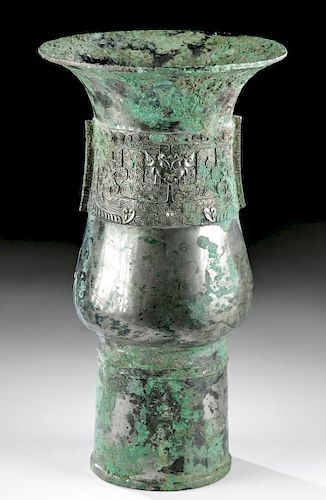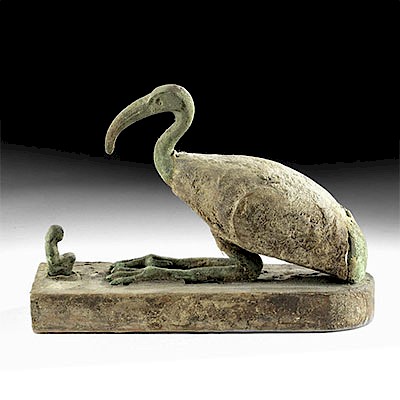Chinese Shang Dynasty Silvered Bronze Zun - XRF Tested
Lot 146
About Seller
Artemis Gallery
686 S Taylor Ave, Ste 106
Louisville, CO 80027
United States
Selling antiquities, ancient and ethnographic art online since 1993, Artemis Gallery specializes in Classical Antiquities (Egyptian, Greek, Roman, Near Eastern), Asian, Pre-Columbian, African / Tribal / Oceanographic art. Our extensive inventory includes pottery, stone, metal, wood, glass and textil...Read more
Categories
Estimate:
$4,000 - $6,000
Absentee vs Live bid
Two ways to bid:
- Leave a max absentee bid and the platform will bid on your behalf up to your maximum bid during the live auction.
- Bid live during the auction and your bids will be submitted real-time to the auctioneer.
Bid Increments
| Price | Bid Increment |
|---|---|
| $0 | $25 |
| $300 | $50 |
| $1,000 | $100 |
| $2,000 | $250 |
| $5,000 | $500 |
| $10,000 | $1,000 |
| $20,000 | $2,500 |
| $50,000 | $5,000 |
| $100,000 | $10,000 |
| $200,000 | $20,000 |
About Auction
By Artemis Gallery
Oct 31, 2019
Set Reminder
2019-10-31 10:00:00
2019-10-31 10:00:00
America/New_York
Bidsquare
Bidsquare : Fine Antiquities, Asian, Ethnographic Art
https://www.bidsquare.com/auctions/artemis-gallery/fine-antiquities-asian-ethnographic-art-4581
Our Halloween Day auction features classical antiquities, ancient and ethnographic art from cultures encompassing the globe, plus fine art. Artemis Gallery info@artemisgallery.com
Our Halloween Day auction features classical antiquities, ancient and ethnographic art from cultures encompassing the globe, plus fine art. Artemis Gallery info@artemisgallery.com
- Lot Description
East Asia, China, Late Shang Dynasty, ca. 12th to 11th century BCE. A fascinating ritual wine vessel, a cast silvered bronze "zun". The body is an elongated vase, with a flaring mouth and a tall, cylindrical foot. Much of the body is smooth, with its shiny silver-color - a result of the high lead content in the bronze - very clear. Around the corseted neck is a wide band of motifs with two raised flanges. Dramatic taotie heads face forward and glare outward from each side. These are surrounded by symbols for thunder and clouds known as leiwen. The zun, with its wide mouth, was used to provide the offering of wine for the deceased during ceremonies, and the symbolism of its ornamentation relates to its funerary function. Size: 5.55" W x 9.9" H (14.1 cm x 25.1 cm)
The taotie is one of the "four fiends" or "four evil creatures" of Chinese mythology, and is a particularly fascinating and ancient symbol - seen on Shang Dynasty bronzes. In the Lushi Chunqiu, known in English as Master Lu's Spring and Autumn Annals, a Chinese encyclopedia compiled around 239 BCE, the taotie is described thusly: "The taotie on Zhou bronzes has a head but no body. When it eats people, it does not swallow them, but harms them" (16/3a Prophecy). This and other ancient descriptions of the creature suggest that it related to making food offerings/sacrifices for the insatiable spirits of the dead. Some scholars believe that the creature is part of the mysterious communication between people and the gods.
We owe the preservation of these ancient bronzes to their burial, either in storage pits, where they were hastily hidden by fleeing members of a defeated elite house, or, more commonly, in tombs. During the Shang dynasty, members of the royalty were accompanied in the afterlife by their bronzes, ceramics, weapons, amulets, and ornaments, and even the human and animal entourage that surrounded them in life: servants, bodyguards, horses, chariots, and charioteers. Each tomb had a set of specialized bronze vessels, of which the zun was just one designed to hold wine.
This piece has been tested for the presence or absence of particular elements via XRF elemental analysis. A full XRF report identifying the quantity of each element present in the sample will accompany purchase. The report certifies that the element composition is consistent with antiquity and will be included with the purchase.
Provenance: private Ventura County, California, USA collection
All items legal to buy/sell under U.S. Statute covering cultural patrimony Code 2600, CHAPTER 14, and are guaranteed to be as described or your money back.
A Certificate of Authenticity will accompany all winning bids.
We ship worldwide and handle all shipping in-house for your convenience.
#148135Intact, with rich turquoise encrusted patina. Interestingly, there is a pattern that looks like impressed fabric on one side, suggesting it lay against cloth for centuries. Much of the originally polished surface shines through the patina.Condition
- Shipping Info
-
All shipping is handled in-house for your convenience. Your invoice from Artemis Gallery will include shipping calculation instructions. If in doubt, please inquire BEFORE bidding for estimated shipping costs for individual items.
-
- Buyer's Premium



 EUR
EUR CAD
CAD AUD
AUD GBP
GBP MXN
MXN HKD
HKD CNY
CNY MYR
MYR SEK
SEK SGD
SGD CHF
CHF THB
THB
















